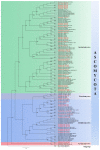Endophytic Fungi Associated with Aquilaria sinensis (Agarwood) from China Show Antagonism against Bacterial and Fungal Pathogens
- PMID: 36422018
- PMCID: PMC9697865
- DOI: 10.3390/jof8111197
Endophytic Fungi Associated with Aquilaria sinensis (Agarwood) from China Show Antagonism against Bacterial and Fungal Pathogens
Abstract
Agarwood is the most expensive non-construction wood product in the world. As a therapeutic agent, agarwood can cure some diseases, but few studies have been carried out on the antagonistic abilities of endophytic fungi associated with agarwood. Agarwood is mainly found in the genus Aquiaria. The objectives of this study are to understand the antimicrobial activities and their potential as biocontrol agents of the endophytic fungi of Aquilaria sinensis. First, fresh samples of A. sinensis were collected from Yunnan and Guangdong Provinces in 2020-2021, and the endophytic fungi were isolated and identified to genus level based on the phylogenetic analyses of the Internal Transcribed Spacer (ITS) region. In this bioassay, 47 endophytic strains were selected to check their bioactivities against three bacterial pathogens viz. Erwinia amylovora, Pseudomonas syringae, and Salmonella enterica; and three fungal pathogens viz. Alternaria alternata, Botrytis cinerea, and Penicillium digitatum. The antibiosis test was carried out by the dual culture assay (10 days), and among the 47 strains selected, 40 strains belong to 18 genera viz. Alternaria, Annulohypoxylon, Aspergillus, Botryosphaeria, Colletotrichum, Corynespora, Curvularia, Daldinia, Diaporthe, Fusarium, Lasiodiplodia, Neofusicoccum, Neopestalotiopsis, Nigrospora, Paracamarosporium, Pseudopithomyces, Trichoderma, Trichosporon and one strain belongs to Xylariaceae had antimicrobial activities. In particular, Lasiodiplodia sp. (YNA-D3) showed the inhibition of all the bacterial and fungal pathogens with a significant inhibition rate. In addition, the strains viz; Curvularia sp. (GDA-3A9), Diaporthe sp. (GDA-2A1), Lasiodiplodia sp. (YNA-D3), Neofusicoccum sp. (YNA-1C3), Nigrospora sp. (GDA-4C1), and Trichoderma sp. (YNA-1C1) showed significant antimicrobial activities and are considered worthy of further studies to identify individual fungal species and their bioactive compounds. This study enriches the diversity of endophytic fungi associated with agarwood, and their potential antagonistic effects against bacterial and fungal pathogens.
Keywords: Lasiodiplodia; agarwood; antibacterial activities; antifungal activities; antimicrobial activities.
Conflict of interest statement
The authors declare no conflict of interest.
Figures




Similar articles
-
Endophytic Fungi Associated with Coffee Leaves in China Exhibited In Vitro Antagonism against Fungal and Bacterial Pathogens.J Fungi (Basel). 2022 Jun 30;8(7):698. doi: 10.3390/jof8070698. J Fungi (Basel). 2022. PMID: 35887454 Free PMC article.
-
Diversity of endophytic fungi isolated from different plant parts of Acacia mangium, and antagonistic activity against Ceratocystis fimbriata, a causal agent of Ceratocystis wilt disease of A. mangium in Malaysia.Front Microbiol. 2022 Nov 8;13:887880. doi: 10.3389/fmicb.2022.887880. eCollection 2022. Front Microbiol. 2022. PMID: 36425026 Free PMC article.
-
Fungal Endophytes: an Alternative Source for Production of Volatile Compounds from Agarwood Oil of Aquilaria subintegra.Microb Ecol. 2017 Jul;74(1):54-61. doi: 10.1007/s00248-016-0908-4. Epub 2017 Jan 5. Microb Ecol. 2017. PMID: 28058469
-
Exploring Endophytic Fungi as Natural Antagonists against Fungal Pathogens of Food Crops.J Fungi (Basel). 2024 Aug 26;10(9):606. doi: 10.3390/jof10090606. J Fungi (Basel). 2024. PMID: 39330366 Free PMC article. Review.
-
The Therapeutic Potential of Agarwood as an Antimicrobial and Anti-Inflammatory Agent: A Scoping Review.Antibiotics (Basel). 2024 Nov 12;13(11):1074. doi: 10.3390/antibiotics13111074. Antibiotics (Basel). 2024. PMID: 39596767 Free PMC article.
Cited by
-
Deciphering the roles of bacterial and fungal communities in the formation and quality of agarwood.Stress Biol. 2024 Sep 20;4(1):40. doi: 10.1007/s44154-024-00179-5. Stress Biol. 2024. PMID: 39302547 Free PMC article.
-
Study of the Antagonism of Biocontrol Strains Against the Blue-Stain Fungus of Rubberwood.J Fungi (Basel). 2025 Jan 12;11(1):55. doi: 10.3390/jof11010055. J Fungi (Basel). 2025. PMID: 39852474 Free PMC article.
-
Biohacking agarwood: the impact of fire drills and brine on endophytes and metabolites of Aquilaria sinensis.BMC Plant Biol. 2025 Apr 28;25(1):555. doi: 10.1186/s12870-025-06574-y. BMC Plant Biol. 2025. PMID: 40295920 Free PMC article.
-
Morpho-phylogenetic evidence reveals novel species and new records of Nigrograna (Nigrogranaceae) associated with medicinal plants in Southwestern China.MycoKeys. 2024 Oct 23;110:1-33. doi: 10.3897/mycokeys.110.132628. eCollection 2024. MycoKeys. 2024. PMID: 39493641 Free PMC article.
-
Comparative analysis of endophytic fungal communities in bamboo species Phyllostachys edulis, Bambusa rigida, and Pleioblastus amarus.Sci Rep. 2023 Nov 27;13(1):20910. doi: 10.1038/s41598-023-48187-1. Sci Rep. 2023. PMID: 38017106 Free PMC article.
References
-
- The IUCN Red List of Threatened Species Version 2017-3. [(accessed on 10 October 2022)]. Available online: www.Iucnredlist.org.
-
- Kalra R., Kaushik N. A review of chemistry, quality and analysis of infected agarwood tree (Aquilaria sp.) Phytochem. Rev. 2017;16:1045–1079. doi: 10.1007/s11101-017-9518-0. - DOI
-
- Azren P.D., Lee S.Y., Emang D., Mohamed R. History and perspectives of induction technology for agarwood production from cultivated Aquilaria in Asia: A review. J. For. Res. 2018;30:1–11. doi: 10.1007/s11676-018-0627-4. - DOI
-
- Lv F.F., Li S.S., Feng J., Liu P.W., Gao Z.H., Yang Y., Xu Y.H., Wei J.H. Hydrogen peroxide burst triggers accumulation of jasmonates and salicylic acid inducing sesquiterpene biosynthesis in wounded Aquilaria sinesis. J. Plant Physiol. 2019;234–235:167–175. doi: 10.1016/j.jplph.2019.02.006. - DOI - PubMed
Grants and funding
LinkOut - more resources
Full Text Sources
Research Materials

